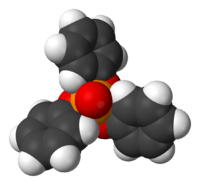Triphenyl phosphate
3.png) | |
 | |
| Names | |
|---|---|
| IUPAC name
Triphenyl phosphate | |
| Identifiers | |
| 115-86-6 | |
| ChEBI | CHEBI:35033 |
| ChEMBL | ChEMBL454511 |
| ChemSpider | 7988 |
| Jmol interactive 3D | Image |
| PubChem | 8289 |
| |
| |
| Properties | |
| C18H15O4P | |
| Molar mass | 326.29 g·mol−1 |
| Appearance | Colorless solid |
| Density | 1.184 g/mL |
| Melting point | 48 to 50 °C (118 to 122 °F; 321 to 323 K) |
| Boiling point | 244 °C (471 °F; 517 K) at 10 mmHg |
| Vapor pressure | 1 mmHg (193 °C)[1] |
| Hazards | |
| Main hazards | Harmful |
| Flash point | 220 °C (428 °F; 493 K)[1] |
| Lethal dose or concentration (LD, LC): | |
| LD50 (Median dose) |
1320 mg/kg (mouse, oral) 3500 mg/kg (rat, oral)[2] |
| US health exposure limits (NIOSH): | |
| PEL (Permissible) |
TWA 3 mg/m3[1] |
| REL (Recommended) |
TWA 3 mg/m3[1] |
| IDLH (Immediate danger |
1000 mg/m3[1] |
| Except where otherwise noted, data are given for materials in their standard state (at 25 °C [77 °F], 100 kPa). | |
| | |
| Infobox references | |
Triphenyl phosphate is the chemical compound with the formula OP(OC6H5)3. This colourless solid is the ester (triester) of phosphoric acid and phenol. It is used as a plasticizer and a fire retardant.[3]
Triphenyl phosphate is prepared by the reaction of phosphorus oxychloride and phenol:
- POCl3 + 3 HOC6H5 → OP(OC6H5)3 + 3 HCl
Safety considerations
Triphenyl phosphate exhibits low acute toxicity by dermal or oral contact.[3]
References
- 1 2 3 4 5 "NIOSH Pocket Guide to Chemical Hazards #0644". National Institute for Occupational Safety and Health (NIOSH).
- ↑ "Triphenyl phosphate". Immediately Dangerous to Life and Health. National Institute for Occupational Safety and Health (NIOSH).
- 1 2 J. Svara, N. Weferling, T. Hofmann "Phosphorus Compounds, Organic" in Ullmann's Encyclopedia of Industrial Chemistry, Wiley-VCH, Weinheim, 2006. doi:10.1002/14356007.a19_545.pub2
This article is issued from Wikipedia - version of the Monday, November 23, 2015. The text is available under the Creative Commons Attribution/Share Alike but additional terms may apply for the media files.